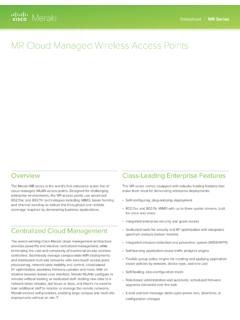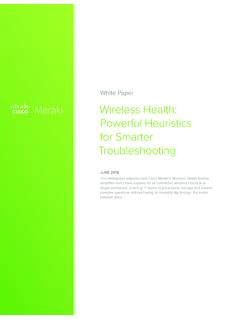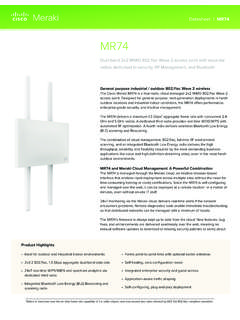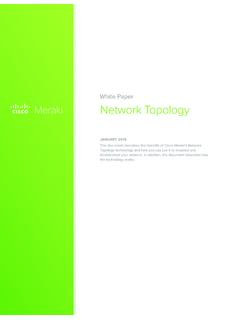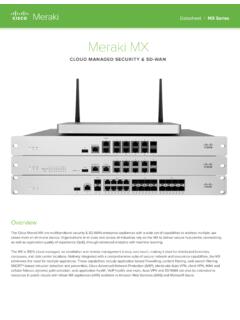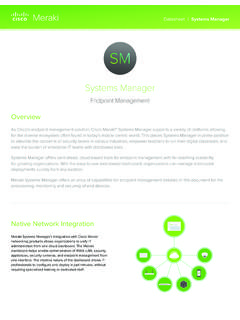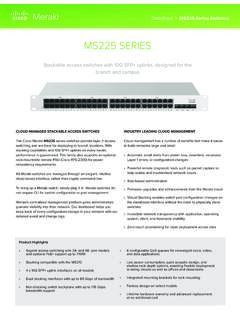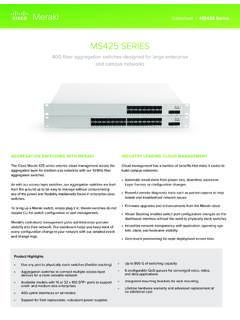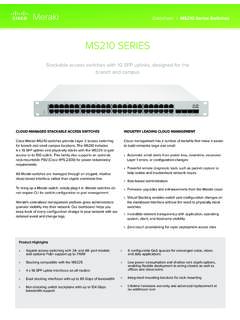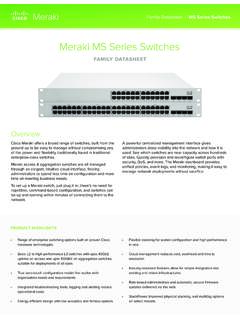Transcription of Wi-Fi 6: The Next Generation of Wireless - Cisco Meraki
1 This whitepaper explores the benefits and capabilities of the sixth Generation of Wi-Fi , based on the amendment to the IEEE WLAN 2019Wi-Fi 6:The Next Generation of Wireless2 Cisco Systems, Inc. | new amendment to the Wi-Fi standard! Every new Generation of Wi-Fi brings an opportunity to pause and consider the transformational changes that will be affecting us in the coming years. Today, Wi-Fi networks already experience bandwidth-intensive media content and multiple Wi-Fi devices per user. Moving forward, networks will face a continued dramatic increase in the number of devices, a tripling of the total global IP traffic, and a diverse range of new technologies that will all heavily rely on with previous generations, Wi-Fi 6 (also known as ) will improve high density performance and provide faster throughput.
2 In addition, this new Generation of Wi-Fi will augment customary speed and density improvements with new capabilities designed for technology trends of the future. IoT connections will represent more than half of all global connected devices by 2022. Virtual and augmented reality network traffic is poised to grow twelve-fold by 2022. Wi-Fi networks of the future need to be nimble and efficient to accommodate increased client density, high throughput requirements, and a diversity of new applications. Wi-Fi 6 offers several new improvements to make it the highest performing set of Wireless protocols ever developed. Not only will Wi-Fi 6 boost overall performance, but it is designed to perform efficiently in real-world scenarios.
3 New features such as OFDMA, uplink MU-MIMO, TWT, BSS color, and new modulation schemes all work together to allow end users to experience always-on connectivity without bottlenecks or performance 1. Cisco Visual Networking Index: Forecast and Trends, 2017-2022 Whitepaper3 Cisco Systems, Inc. | 1999, Wi-Fi has evolved rapidly to provide significantly higher throughput and performance. In 2013, handed the baton to by providing users with higher speed and higher reliability while conserving power for mobile devices. Over the last several years, Wave 2 has improved maximum data rates beyond 1 Gbps. While Wave 1 and Wave 2 provided significantly increased throughput over older standards, the ability to get reliable multigigabit performance and spectral efficiency was still missing from the Wi-Fi standard and required an additional development of the amendment started in 2013, as a group of technical experts came together to discuss the challenges that Wi-Fi might face in coming years.
4 Wi-Fi was contending with being a victim of its own success, as its use became ubiquitous. Experts noted the projected increase of Wi-Fi devices such as mobile phones, consumer electronics, and IoT devices. With more devices, Wi-Fi would face increasing interference and decreased performance. The group saw a need to get legacy devices, IoT devices, and high-throughput devices to all work together efficiently. The task group discussed problem statements and solutions, ultimately outlining the requirements for Wi-Fi 6, also known as High Efficiency WLAN. This new Generation of Wi-Fi will be intelligent enough to enable the dense and pervasive Wireless environments of the of Wi-Fi4 Cisco Systems, Inc. | forward, several trends are changing Wireless networks as we know them today.
5 Wireless faces an increasing use of high throughput applications, increased density of Wireless devices, and a change in the needs of Throughput RequirementsThe total amount of internet traffic from 2017-2022 will be higher than in the previous 32 years of the internet. Wi-Fi will be the transport mechanism for more than half of that traffic. In addition to existing bandwidth challenges, an influx of new Wi-Fi 6 mobile devices is expected to hit networks in late 2019 and 2020. The data traffic per smartphone is expected to increase by ten times from 2016 to 2022. Adding to Wi-Fi data rate requirements, 5G networks will be offloading significant amounts of traffic to Wi-Fi . These developments will cause challenges for Wi-Fi networks, which are already dealing with a steady influx of increasing clients, higher client density, and high throughput applications.
6 Bandwidth-intensive 4K video is expected to grow from three percent of all IP traffic in 2017 to twenty-two percent in 2022. 4K video already challenges networks with 15 to 18 Mbps throughput, but 8K streaming video is coming online as well, consuming roughly 1 Gbps of throughput. Augmented and virtual reality applications will have increasing use, and consume anywhere from 600 Mbps to 1 Gbps of traffic. These new bandwidth challenges will require worldwide Wi-Fi connection speeds to increase between 2017 and Next Generation Wireless LandscapeFigure 2. Projected average global Wi-Fi network connection speeds compared to Systems, Inc. | Density NetworksThe next several years will see a 50% increase in networked devices per person, resulting in an average of connected devices per person.
7 As device counts increase, users are also expecting a more rich and seamless Wireless experience. However, laptops, wearables, and mobile phones will cause significant interference and degraded performance for the rest of the network. In addition to the steady stream of increased clients, network admins will have to account for dynamic changes as mobile users physically move locations more often. As multiple mobile clients move through spaces that have overlapping coverage from Wireless stations (STA), traditional collision avoidance protocols begin to decrease in efficiency. This effect is particularly pronounced at higher data rates and modulation schemes that are more susceptible to Network NeedsWith four times as many Wi-Fi connected devices as humans on the planet, the world s population is more connected than ever before.
8 The days of workers tethered to work stations around centralized company data centers are on the decline. The previous five Wi-Fi generations assisted this untethering transition, and the next Generation looks to push the bounds of mobility even further. Wi-Fi 6 will lay the groundwork for the growing use of applications like collaborative HD video streaming, augmented reality on the manufacturing floor, virtual reality entertainment, and IoT. Internet-of-things devices will represent more than half of all global connected devices and connections by 2022, and 80% of new IoT projects will be Wireless . IoT devices are provided benefits with Wi-Fi 6, potentially allowing three times better power efficiency, and additional spectral efficiency.
9 This will lower the barrier of development for warehouse robots, Wireless -dependent asset tracking, sophisticated sensors, and 3. Example of a high-density network6 Cisco Systems, Inc. | the challenges in the changing Wireless landscape, users expect Wireless deployments to be pervasive, and to support high capacity and a high density of clients. Wi-Fi 6 is designed to meet these changing needs performance that will exceed Wave 2 by over 3-4 times, support for higher density with more efficient airtime, support for a higher scale of client devices, and significant battery saving. While Wi-Fi 6 will be able to deliver theoretical data-rate growth of around 37%, its largest benefit is the ability to deliver high-efficiency performance in real-world environments.
10 As the number of clients increase, Wi-Fi 6 will be able to sustain far more consistent data throughput than previous and amendments. There are controlled environments with a very small amount of clients where previous generations of Wi-Fi may provide higher throughput. This is due to the longer frames and wider guard intervals of , which help provide addition to consistent real-world data throughput, Wi-Fi 6 comes with the additional benefits of wider coverage ranges, better reliability, better IoT operation, and new technologies, such as OFDMA, help contribute to the new benefits for next Generation Wireless networks. Borrowed from LTE technology, OFDMA helps to significantly reduce overhead and latency.
